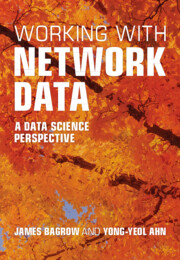Book contents
- Frontmatter
- Contents
- Preface
- Part I Background
- Part II Applications, tools, and tasks
- Chapter 5 The life cycle of a network study
- Chapter 6 Gathering data
- Chapter 7 Extracting networks from data — the “upstream task”
- Chapter 8 Implementation: storing and manipulating network data
- Chapter 9 Incorporating node and edge attributes
- Chapter 10 Awful errors and how to amend them
- Chapter 11 Explore and explain: statistics for network data
- Chapter 12 Understanding network structure and organization
- Chapter 13 Visualizing networks
- Chapter 14 Summarizing and comparing networks
- Chapter 15 Dynamics and dynamic networks
- Chapter 16 Machine learning
- Interlude — Good practices for scientific computing
- Part III Fundamentals
- Conclusion
- Bibliography
- Index
Chapter 13 - Visualizing networks
from Part II - Applications, tools, and tasks
Published online by Cambridge University Press: 06 June 2024
- Frontmatter
- Contents
- Preface
- Part I Background
- Part II Applications, tools, and tasks
- Chapter 5 The life cycle of a network study
- Chapter 6 Gathering data
- Chapter 7 Extracting networks from data — the “upstream task”
- Chapter 8 Implementation: storing and manipulating network data
- Chapter 9 Incorporating node and edge attributes
- Chapter 10 Awful errors and how to amend them
- Chapter 11 Explore and explain: statistics for network data
- Chapter 12 Understanding network structure and organization
- Chapter 13 Visualizing networks
- Chapter 14 Summarizing and comparing networks
- Chapter 15 Dynamics and dynamic networks
- Chapter 16 Machine learning
- Interlude — Good practices for scientific computing
- Part III Fundamentals
- Conclusion
- Bibliography
- Index
Summary
In this chapter, we introduce visualization techniques for networks, what problems we face, and solutions we use, to make those visualizations as effective as possible. Visualization is an essential tool for exploring network data, revealing patterns that may not be easily inferred from statistics alone. Although network visualization can be done in many ways, the most common approach is through two-dimensional node-link diagrams. Properly laying out nodes and choosing the mapping between network and visual properties is essential to create an effective visualization, which requires iteration and fine-tuning. For dense networks, filtering or aggregating the data may be necessary. Following an iterative, back-and-forth workflow is essential, trying different layout methods and filtering steps to show the networks structure best while keeping the original questions and goals in mind. Visualization is not always the endpoint of a network analysis but can also be a useful step in the middle of an exploratory data analysis pipeline, similar to traditional statistical visualization of non-network data.
Keywords
- Type
- Chapter
- Information
- Working with Network DataA Data Science Perspective, pp. 203 - 222Publisher: Cambridge University PressPrint publication year: 2024

